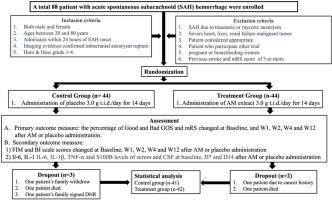Effect of astragalus membranaceus on neurological function in acute aneurysmal subarachnoid hemorrhage patients with high inflammation: A preliminary randomized, double-blind, placebo-controlled clinical trial
IF 3
3区 医学
Q1 INTEGRATIVE & COMPLEMENTARY MEDICINE
Journal of Traditional and Complementary Medicine
Pub Date : 2024-04-11
DOI:10.1016/j.jtcme.2024.04.002
引用次数: 0
Abstract
Background and aim
Astragalus membranaceus (AM) is a traditional Chinese herb. Our previous study revealed that AM can enhance neurological function in patients with acute intracerebral hemorrhage. The aim of this study was to investigated the effects of AM on patients with acute aneurysmal subarachnoid hemorrhage (aSAH).
Experimental procedure
Eighty-eight patients experiencing acute aSAH were randomly allocated to either the treatment group (TG) comprising 44 patients, who received 3 g of AM orally thrice daily for 14 days, or the control group (CG) with 44 patients, who received 3 g of a placebo.
Results
Eighty-three patients (41 in CG and 42 in TG) completed the trial. Stratified analyses revealed serum interleukin-6 (IL-6) median ≥7.28 pg/mL at baseline. The percentage of good GOS scores (GOS 4 or 5) at two weeks (W2) and four weeks (W4) was significantly higher in TG than in CG (W2: 35.3 % vs. 7.7 %, p = 0.042; W4: 62.5 % vs. 30.8 %, p = 0.044). Moreover, a higher percentage of Barthel index scores (>60) was observed in TG than in CG at W2 (35.3 % vs. 7.7 %, p = 0.042) after AM or placebo administration.
Conclusion
Administering AM for 14 days has shown potential in enhancing neurological function four weeks post-aSAH onset, especially in patients with a serum IL-6 level median ≥7.28 pg/mL. Therefore, further research is warranted to explore the anti-inflammatory role of AM. However, this study's limitations include a small sample size and the single-center design, signifying its status as a preliminary investigation.

黄芪对急性动脉瘤性蛛网膜下腔出血高炎症患者神经功能的影响:一项初步随机、双盲、安慰剂对照临床试验
背景和目的黄芪(AM)是一种传统中草药。我们之前的研究显示,黄芪能增强急性脑出血患者的神经功能。实验过程88名急性蛛网膜下腔出血患者被随机分配到治疗组(TG)和对照组(CG),治疗组有44名患者,每天口服3克AM,共14天;对照组有44名患者,每天口服3克安慰剂。分层分析显示,基线血清白细胞介素-6(IL-6)中位数≥7.28 pg/mL。在两周(W2)和四周(W4)的良好 GOS 评分(GOS 4 或 5 分)中,TG 显著高于 CG(W2:35.3% 对 7.7%,p = 0.042;W4:62.5% 对 30.8%,p = 0.044)。此外,在 W2(35.3 % vs. 7.7 %,p = 0.042)时,观察到 AM 或安慰剂给药后,TG 的 Barthel 指数评分(>60)百分比高于 CG(35.3 % vs. 7.7 %,p = 0.042)。因此,有必要进一步研究 AM 的抗炎作用。然而,这项研究的局限性包括样本量较小和单中心设计,这表明它只是一项初步研究。
本文章由计算机程序翻译,如有差异,请以英文原文为准。
求助全文
约1分钟内获得全文
求助全文
来源期刊

Journal of Traditional and Complementary Medicine
Medicine-Complementary and Alternative Medicine
CiteScore
9.30
自引率
6.70%
发文量
78
审稿时长
66 days
期刊介绍:
eJTCM is committed to publish research providing the biological and clinical grounds for using Traditional and Complementary Medical treatments as well as studies that demonstrate the pathophysiological and molecular/biochemical bases supporting the effectiveness of such treatments. Review articles are by invitation only.
eJTCM is receiving an increasing amount of submission, and we need to adopt more stringent criteria to select the articles that can be considered for peer review. Note that eJTCM is striving to increase the quality and medical relevance of the publications.
 求助内容:
求助内容: 应助结果提醒方式:
应助结果提醒方式:


